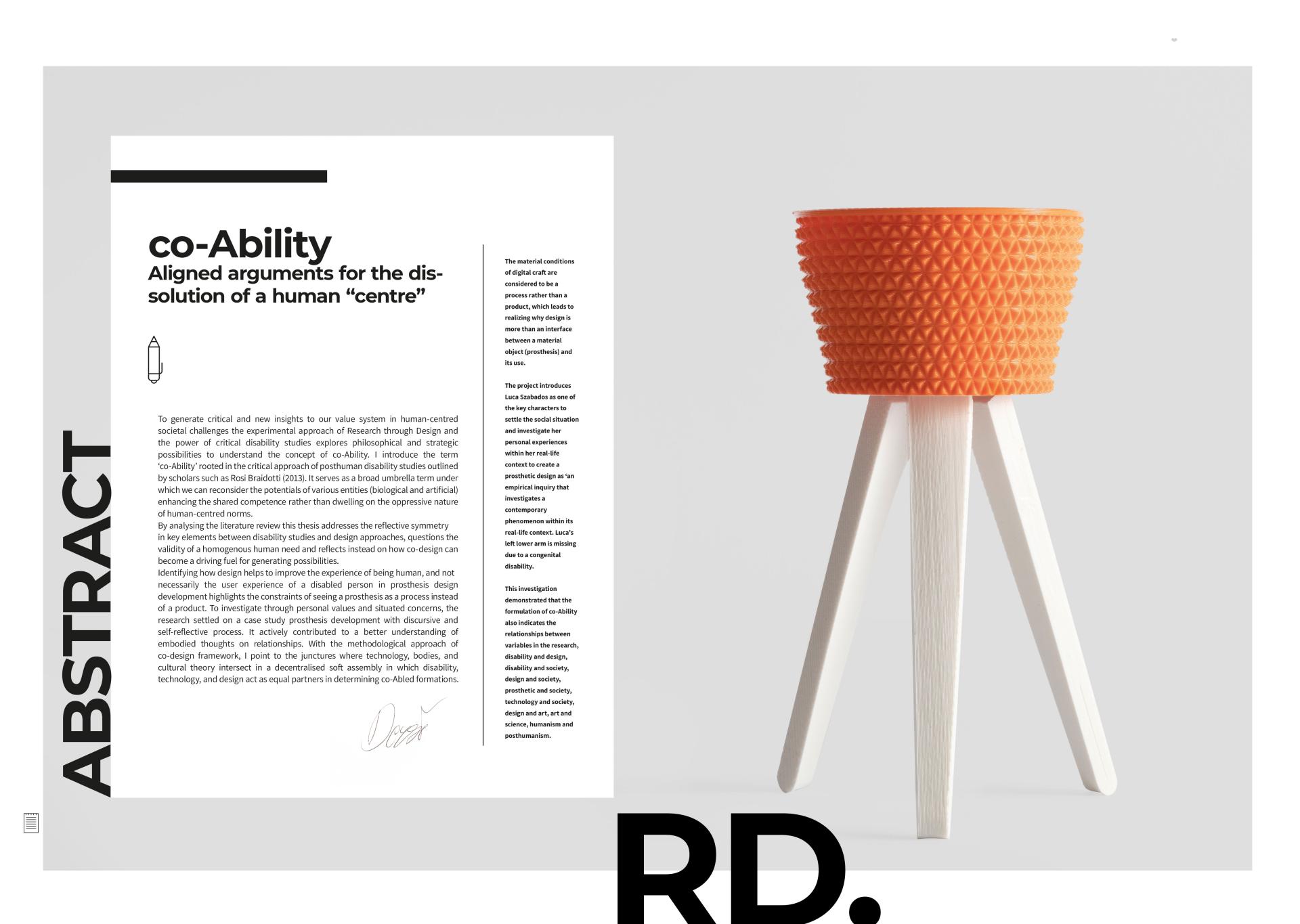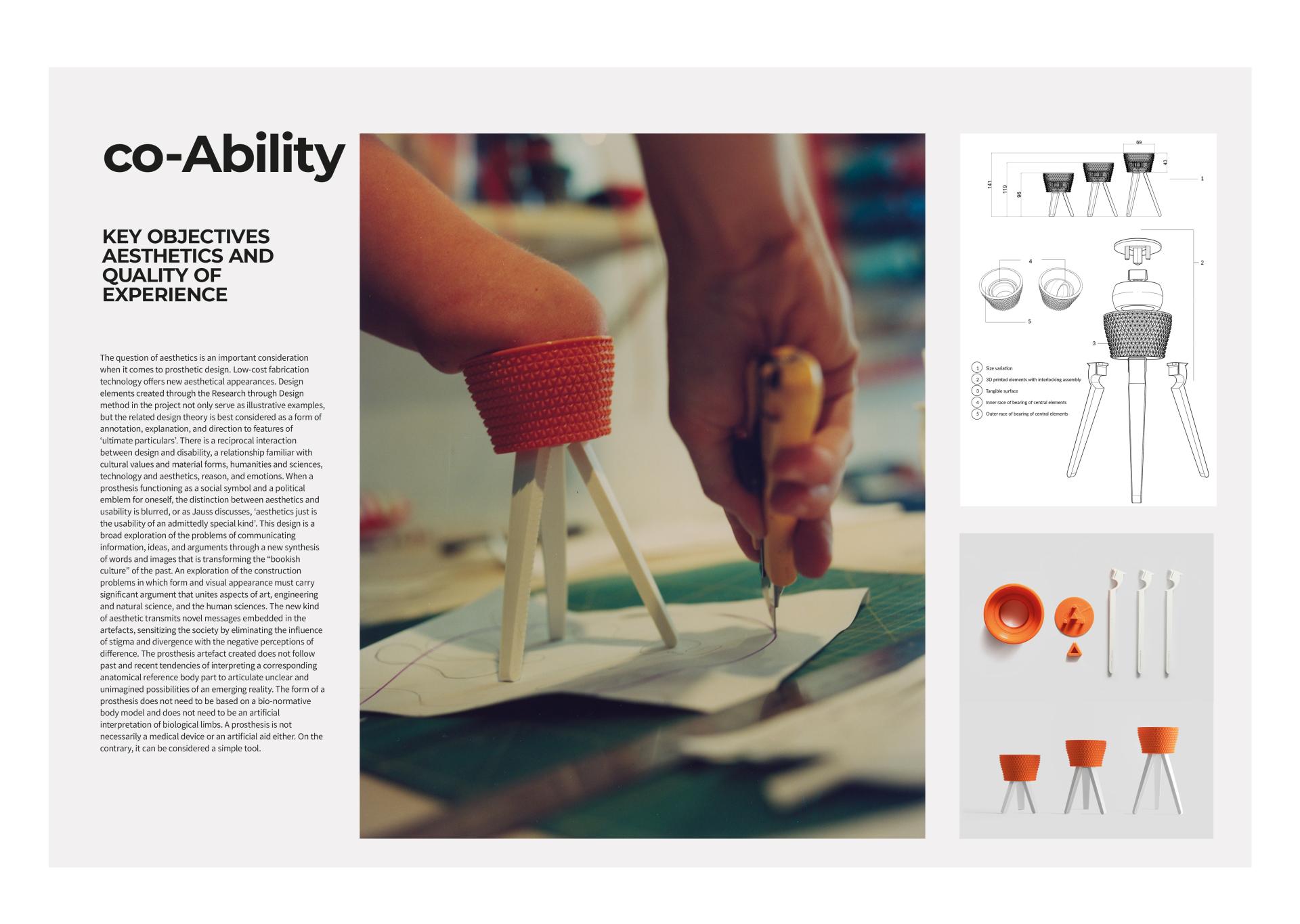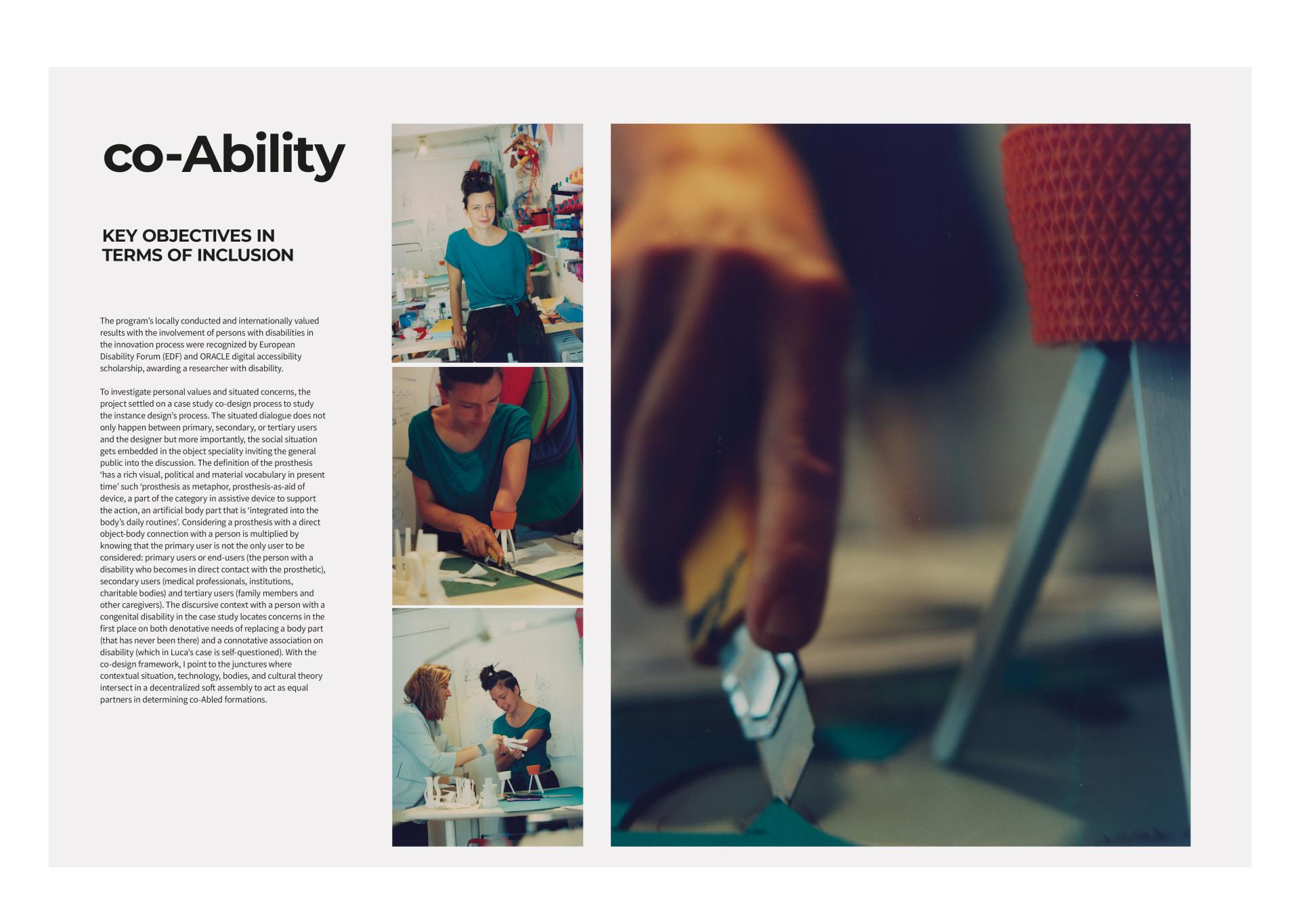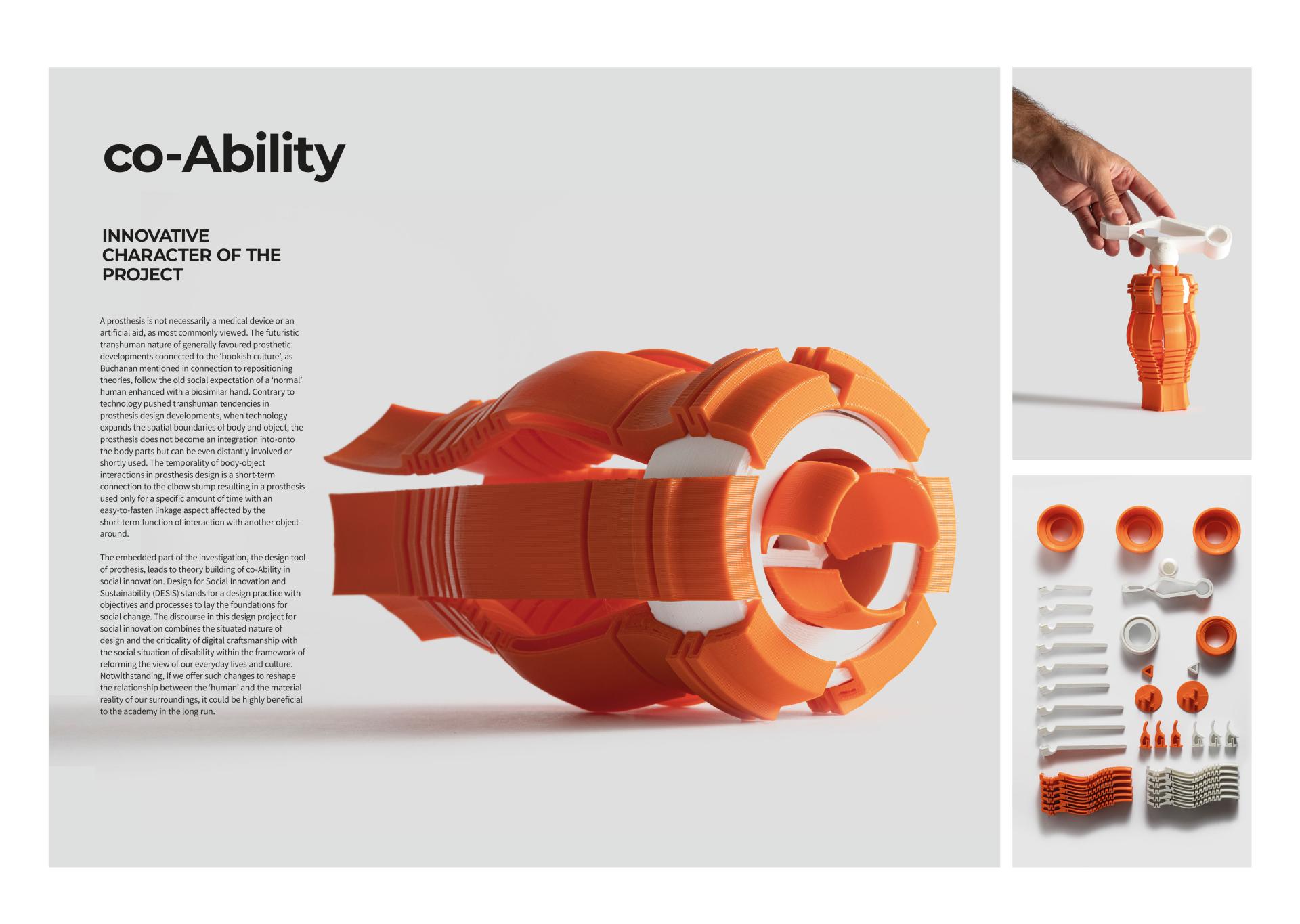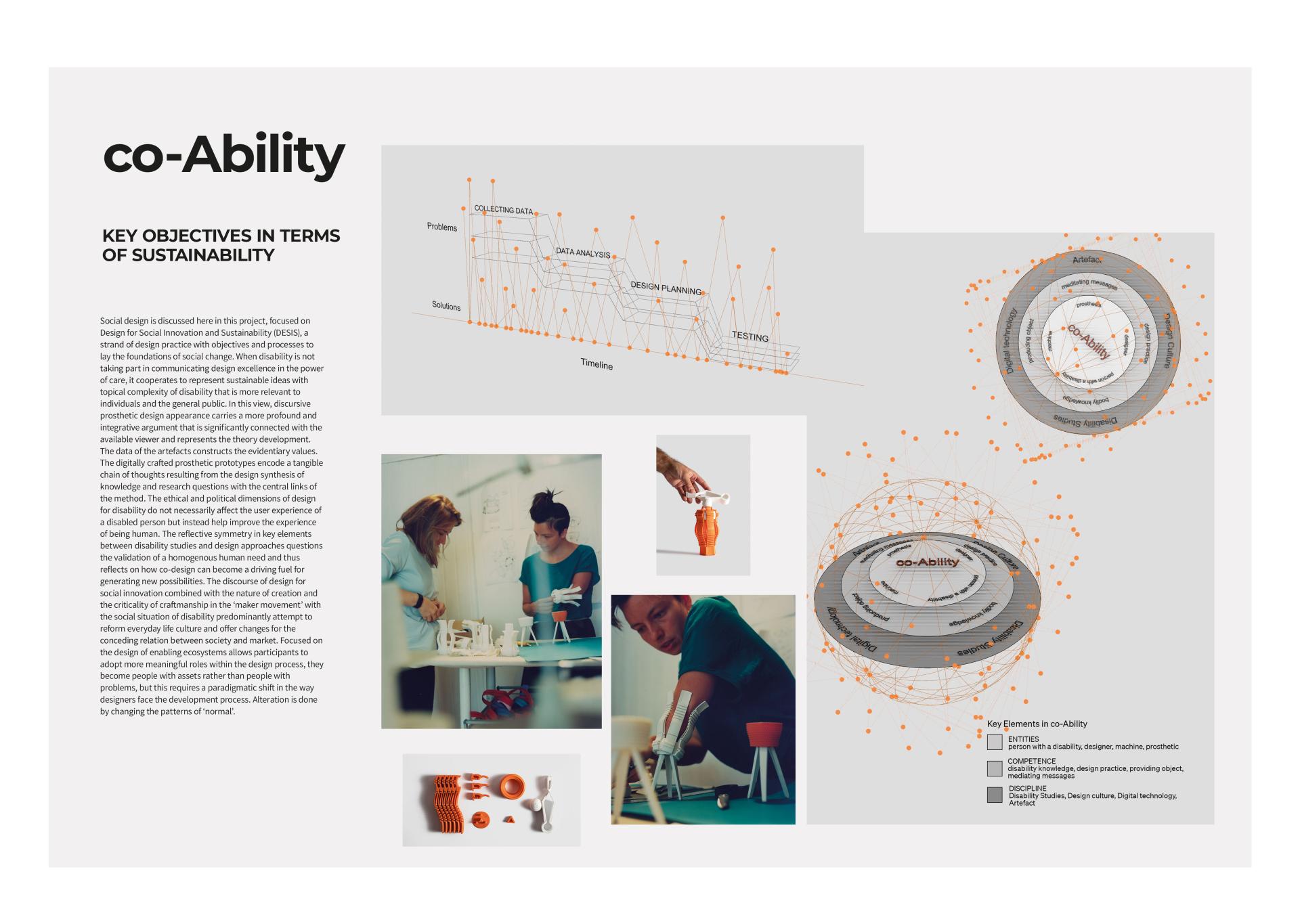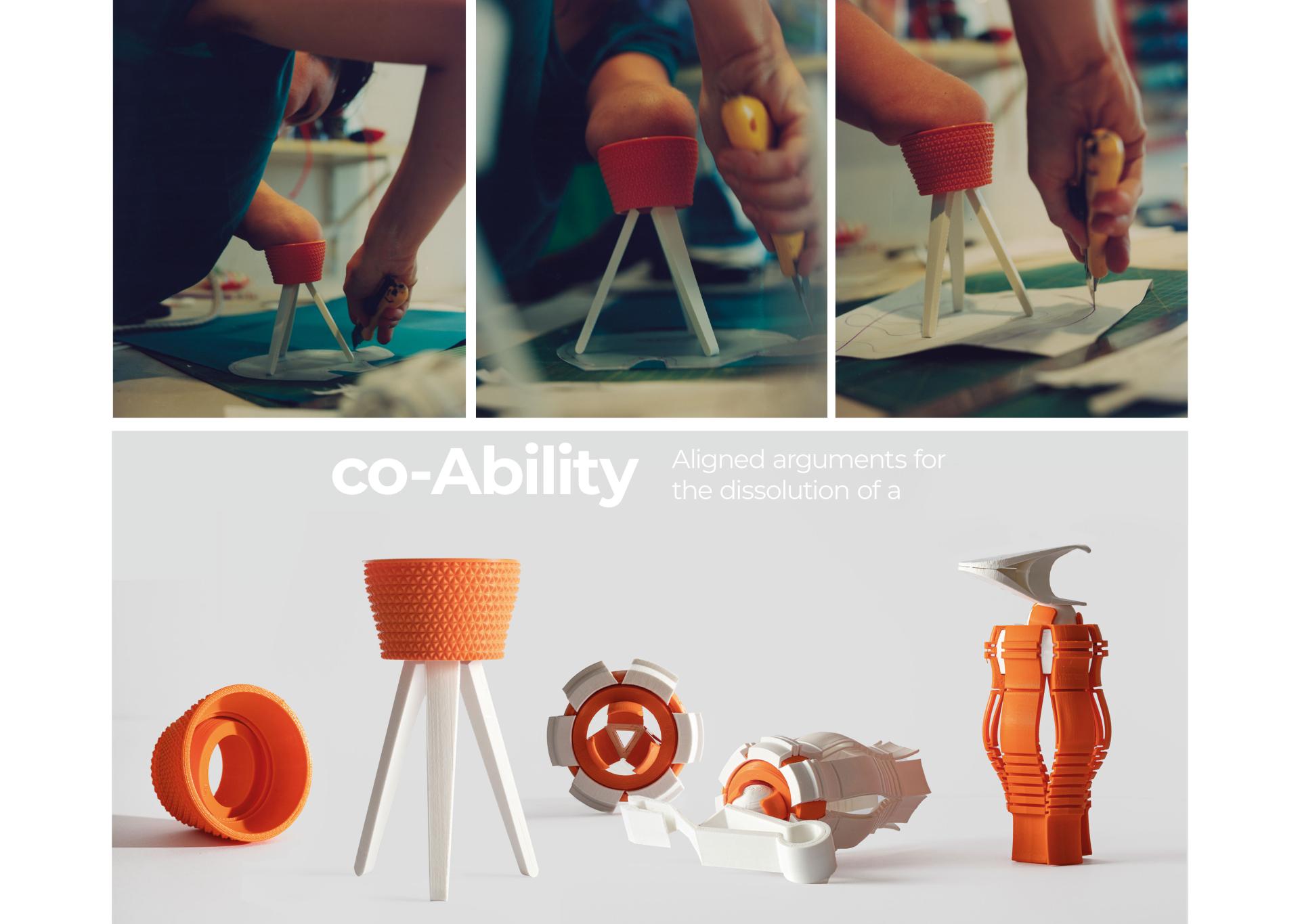co-Ability processes
Basic information
Project Title
Full project title
Category
Project Description
With the methodological approach of co-design framework, I point to the junctures where technology, bodies, and cultural theory intersect in a decentralized soft assembly in which disability, technology, and design act as equal partners in determining co-Abled formations. A Dissertation Submitted to Doctoral School of Moholy-Nagy University of Art and Design Budapest (MOME DS) In Partial Fulfilment of the Requirements for the Degree DLA (Doctor of Liberal Art)
Geographical Scope
Project Region
Urban or rural issues
Physical or other transformations
EU Programme or fund
Which funds
Description of the project
Summary
To generate critical and new insights into our value system in human-centred societal challenges the experimental approach of Research through Design and the power of critical disability studies explores philosophical and strategic possibilities to understand the concept of co-Ability. I introduce the term ‘coAbility’ rooted in the critical approach of posthuman disability studies outlined by scholars such as Rosi Braidotti (2013). It serves as a broad umbrella term under which we can reconsider the potentials of various entities (biological and artificial) enhancing the shared competence rather than dwelling on the oppressive nature of human-centred norms. By analyzing the literature review, this thesis addresses the reflective symmetry in key elements between disability studies and design approaches, questions the validity of a homogenous human need and reflects instead on how co-design can become a driving fuel for generating possibilities. Identifying how design helps to improve the experience of being human, and not necessarily the user experience of a disabled person in prosthesis design development highlights the constraints of seeing a prosthesis as a process instead of a product. To investigate personal values and situated concerns, the research settled on a case study of prosthesis development with the discursive and self-reflective process. It actively contributed to a better understanding of embodied thoughts on relationships. With the methodological approach of co-design framework, I point to the junctures where technology, bodies, and cultural theory intersect in a decentralized soft assembly in which disability, technology, and design act as equal partners in determining co-Abled formations.
Key objectives for sustainability
Social design is discussed here in this project, focused on Design for Social Innovation and Sustainability (DESIS), a strand of design practice with objectives and processes to lay the foundations of social change. When disability is not taking part in communicating design excellence in the power of care, it cooperates to represent sustainable ideas with topical complexity of disability that is more relevant to individuals and the general public. In this view, discursive prosthetic design appearance carries a more profound and integrative argument that is significantly connected with the available viewer and represents the theory development. The data of the artefacts constructs the evidentiary values. The digitally crafted prosthetic prototypes encode a tangible chain of thoughts resulting from the design synthesis of knowledge and research questions with the central links of the method. The ethical and political dimensions of design for disability do not necessarily affect the user experience of a disabled person but instead help improve the experience of being human. The reflective symmetry in key elements between disability studies and design approaches questions the validation of a homogenous human need and thus reflects on how co-design can become a driving fuel for generating new possibilities. The discourse of design for social innovation combined with the nature of creation and the criticality of craftmanship in the ‘maker movement’ with the social situation of disability predominantly attempt to reform everyday life culture and offer changes for the conceding relation between society and market. Focused on the design of enabling ecosystems allows participants to adopt more meaningful roles within the design process, they become people with assets rather than people with problems, but this requires a paradigmatic shift in the way designers face the development process. Alteration is done by changing the patterns of ‘normal’.
Key objectives for aesthetics and quality
The question of aesthetics is an important consideration when it comes to prosthetic design. Low-cost fabrication technology offers new aesthetical appearances. Design elements created through the Research through Design method in the project not only serve as illustrative examples, but the related design theory is best considered as a form of annotation, explanation, and direction to features of ‘ultimate particulars’. There is a reciprocal interaction between design and disability, a relationship familiar with cultural values and material forms, humanities and sciences, technology and aesthetics, reason, and emotions. When a prosthesis functioning as a social symbol and a political emblem for oneself, the distinction between aesthetics and usability is blurred, or as Jauss discusses, ‘aesthetics just is the usability of an admittedly special kind’. This design is a broad exploration of the problems of communicating information, ideas, and arguments through a new synthesis of words and images that is transforming the “bookish culture” of the past. An exploration of the construction problems in which form and visual appearance must carry significant argument that unites aspects of art, engineering and natural science, and the human sciences. The new kind of aesthetic transmits novel messages embedded in the artefacts, sensitizing the society by eliminating the influence of stigma and divergence with the negative perceptions of difference. The prosthesis artefact created does not follow past and recent tendencies of interpreting a corresponding anatomical reference body part to articulate unclear and unimagined possibilities of an emerging reality. The form of a prosthesis does not need to be based on a bio-normative body model and does not need to be an artificial interpretation of biological limbs. A prosthesis is not necessarily a medical device or an artificial aid either. On the contrary, it can be considered a simple tool.
Key objectives for inclusion
The program’s locally conducted and internationally valued results with the involvement of persons with disabilities in the innovation process were recognized by European Disability Forum (EDF) and ORACLE digital accessibility scholarship, awarding a researcher with disability.
To investigate personal values and situated concerns, the project settled on a case study co-design process to study the instance design’s process. The situated dialogue does not only happen between primary, secondary, or tertiary users and the designer but more importantly, the social situation gets embedded in the object speciality inviting the general public into the discussion. The definition of the prosthesis ‘has a rich visual, political and material vocabulary in present time’ such ‘prosthesis as metaphor, prosthesis-as-aid of device, a part of the category in assistive device to support the action, an artificial body part that is ‘integrated into the body’s daily routines’. Considering a prosthesis with a direct object-body connection with a person is multiplied by knowing that the primary user is not the only user to be considered: primary users or end-users (the person with a disability who becomes in direct contact with the prosthetic), secondary users (medical professionals, institutions, charitable bodies) and tertiary users (family members and other caregivers). The discursive context with a person with a congenital disability in the case study locates concerns in the first place on both denotative needs of replacing a body part (that has never been there) and a connotative association on disability (which in Luca’s case is self-questioned). With the co-design framework, I point to the junctures where contextual situation, technology, bodies, and cultural theory intersect in a decentralized soft assembly to act as equal partners in determining co-Abled formations.
Results in relation to category
Prosthesis prototyping provides the possibility of creating a set of ‘boundary objects’ within design discussions, including latent perspectives carried out concerning people who need it the most. In particular, the in-depth single case study was chosen because of personal interest in an individual with a contextual situation. The embedded part of the investigation, the design tool of prothesis, leads to theory building of co-Ability in social innovation. Rittel and Webber suggested considering ‘wicked problems’ in contested social issues that are complex and fragmented; therefore, they could not be ‘tamed’ through standard rational, analytical approaches. With the co-design framework, I point to the junctures where technology, bodies, and cultural theory intersect in a decentralized soft assembly in which disability, technology, and design act as equal partners in determining co-Abled formations. The relationship between ‘head’ and ‘hand’ + ‘materials’ and ‘tools’ manifest themselves in the context, instead of bilateral symmetry critically addressing the transversal form of understanding the bond that connects them.
Last but not least, the co-design case study presents the role of a designer not as an external expert but as a participant of the research with first-person perspectives. The project brings social sciences and critical philosophy in posthumanism into the design discussion, questioning the complex phenomena of a normalized society that affect a marginalized population and every human being. Since we live in a period when technology is increasingly integrated into our everyday lives, the scope of discussion here needs to be extended to Posthuman Studies that invite disability studies to be part of a broader movement with ongoing debates on complex contemporary problems.
How Citizens benefit
The project introduces Luca Szabados as the key character to settle the social situation and investigate her personal experiences within her real-life context to create a prosthetic design as an empirical inquiry that investigates a contemporary phenomenon within its real-life context. Luca’s left lower arm is missing due to a congenital disability. As a part of the project, a new educational curriculum was built at Moholy-Nagy University of Arts and Design object design department between 2017-2020. As such, reflecting on the local approaches, the critical role of the unique Hungarian remarkable education history resonates with the programs developed with an integrative practice determined by the specific user circle. Csillagház Primary School performs the education and teaching of children with multiple disabilities. The series of educational courses was launched in 2017 and evolved in a ‘generative’ manner from an initial smaller-scale idea responding flexibly to life-like effects in the following years, involving students and lecturers from the University of Applied Arts Vienna. ‘The word “generative” directs attention to a subset where potentially multiple results can be produced using the generating system. The multi-stage educational program was implemented with the participation of M.A. students interpreting contemporary areas of design discourse through critical analysis of disability-related to children with multiple disabilities. As a follow-up for each educational program, the publication of the results was well implemented on diverse platforms (conferences, courses, workshops, publications). The study’s locally conducted and internationally valued results that summarise the knowledge from all academic programs and mainly the doctoral research involving persons with disabilities in the innovation process was recognised by European Disability Forum and ORACLE digital accessibility scholarship, awarding a researcher with disability.
Physical or other transformations
Innovative character
Innovation in prosthetic aspect: A prosthesis is not necessarily a medical device or an artificial aid, as most commonly viewed. The futuristic transhuman nature of generally favoured prosthetic developments connected to the ‘bookish culture’, as Buchanan mentioned in connection to repositioning theories, follow the old social expectation of a ‘normal’ human enhanced with a biosimilar hand. Contrary to technology pushed transhuman tendencies in prosthesis design developments, when technology expands the spatial boundaries of body and object, the prosthesis does not become an integration into-onto the body parts but can be even distantly involved or shortly used. The temporality of body-object interactions in prosthesis design is a short-term connection to the elbow stump resulting in a prosthesis used only for a specific amount of time with an easy-to-fasten linkage aspect affected by the short-term function of interaction with another object around.
The embedded part of the investigation, the design tool of prothesis, leads to theory building of co-Ability in social innovation. Design for Social Innovation and Sustainability (DESIS) stands for a design practice with objectives and processes to lay the foundations for social change. The discourse in this design project for social innovation combines the situated nature of design and the criticality of digital craftsmanship with the social situation of disability within the framework of reforming the view of our everyday lives and culture. Notwithstanding, if we offer such changes to reshape the relationship between the ‘human’ and the material reality of our surroundings, it could be highly beneficial to the academy in the long run.
Learning transferred to other parties
One of the valuable outputs of the research team is the collection documented in a doctoral dissertation is for the reader, which does not rule out being a viewer of design exhibition at the same time. However, the large textual documentation of the research project is intended for ‘Internal focus/audience’ (designers and academics). A Dissertation Submitted to Doctoral School of the Moholy-Nagy University of Art and Design Budapest (MOME DS) In Partial Fulfilment of the Requirements for the Degree DLA (Doctor of Liberal Art). The situated design framework for co-Ability invites further analysis on “reflective practice,” “reflection-in-action,” and “knowing-in-action,” which led to the exploration of additional research outside of the project by considering co-ability in situated actions. The projects were presented and disseminated at conferences, in publications and various educational programs, such as an article on co-Ability practices was published at the 8th biannual Nordic Design Research Society (NORDES) conference Aalto University, Finland.
To provide further intellectual service, an art installation is a comprehensive representation for an external audience with broader cultural background. Calling Design to represent scientific results in ‘second-order consequence’ and affect general culture has a long and respectable history. Art contributed extensively to the constructive process of understanding the world we live in by celebrating, promoting and communicating science. Prosthetic prototypes represent the tangible chain of thoughts resulting from the design synthesis of knowledge and research question with the central links of the method. The new realities of co-Ability were understood, and discursive prototypes were made to discuss the new reality of the concept. In this case study, it is not the final artefacts that are rigorous but rather the process documented by the prototypes; in fact, rigour in research is the strength of the chain of reasoning.

